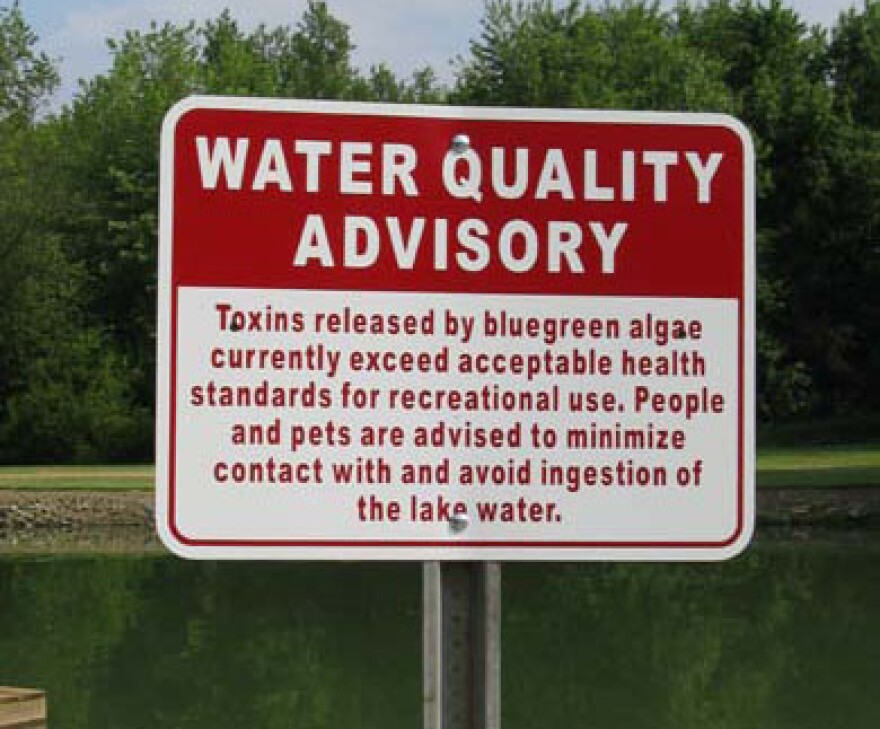Warm weather means cities along Lake Erie are bracing for algae. The toxic blooms threaten drinking water supplies and have been directly linked to farm fertilizer runoff. WOSU’s Sam Hendren reports on what some agricultural experts are doing to limit fertilizer in the Lake Erie watershed.
On a park bench in Huron, Steve Nelson gazes out across a tranquil Lake Erie. What brings him back time and time again?
“Memories,” Nelson says.
Nelson’s been fishing Lake Erie since he was a boy. He says he remembers when the lake was heavily polluted. Now, he says, it’s different.
“This is gorgeous," he says. "It’s a lot cleaner."
A rebirth of the lake
Lake Erie has suffered at man’s hand. The Cuyahoga River, which empties into Erie, was so polluted in the late '60 that it caught fire, repeatedly. In the early ‘70s, the lake was declared dead.
That spurred passage of the Clean Water Act, and water quality began to improve. Jay Martin is an agricultural engineering professor at Ohio State University.
“Lake Erie had a resurgence and actually had pretty good water quality in the early ‘90s. Now in the mid ‘90s, we saw the concentrations of phosphorous going into the lake start to increase,” Martin says.
That phosphorus, from municipal sewage, leaking septic tanks and fertilizers now causes toxic algae blooms. They’ve become so bad that warning signs are posted along the lakefront. Sara Fuller says she loves Lake Erie, but she won’t go into the water.

“If we can’t get in and enjoy ourselves, we can at least hear the crashing of the waves and the scenery is really nice,” Fuller says.
But, he acknowledges, "smelling the dead fish, it’s not very appealing. It makes me wonder how clean it is,” Fuller says.
Not very, researchers say. Algae can release the toxin microcystin. It forced nearly a half-million people in Toledo to go without drinking water for nearly three days two summers ago when a massive bloom developed over the city’s water intake pipe. OSU professor Jay Martin says farm fertilizer is the biggest culprit:
The magic number
“The majority of nutrients that come into western Lake Erie are coming from agricultural sources either from field run-off or fertilizer that’s applied or manure that’s applied to those watersheds,” Martin says.
Ohio, Michigan and Ontario have agreed to cut phosphorous emissions into Lake Erie 40 percent by 2025. Martin says it’s a reachable goal.
There are ways to get to the 40 percent. It’s just going to require that farmers continue to adopt best management plans,” Martin says.
Points further south
And some farmers are doing that.
Seventy miles south of Lake Erie in Hardin County, farmer Chris Kurt takes me out to see some new farming techniques designed to keep nutrients from entering Lake Erie. One of them is called a two-stage ditch. It’s overgrown with vegetation – and that’s by design.
“The whole theory behind it is to slow the water down, have lots of vegetation in the ditch to take up nutrients and reduce erosion,” Kurt says.
New uses for old ideas
What you can’t see in the adjoining soy-bean field are the underground perforated pipes. They siphon water into the ditch. The idea isn’t new, but installing a device to stop the water flow is.
“We block the water, store the water in the field, leave it out there and leave the nutrients out there, too. Gives a chance for any nutrients in the water time to leach out before you let the water flow into the watershed,” Kurt says.
This gives crops more time to absorb nutrients, lessening the need to reapply expensive fertilizer. Kurt regulates water flow at the field’s edge.
“You can see the water’s flowing through. Now if I shove these all down, the water would actually build up,” Kurt says.
From there, the water drains into the ditch on its way to the Blanchard River, part of the Lake Erie watershed.
“It’s still flowing free and you can see it’s flowing clear,” Kurt says.
Kurt’s acreage is now a demonstration farm meant to encourage other farmers to follow suit. Aaron Heilers oversees the project.
“That’s the point of these demonstration farms is to find those best management practices that any farmer can implement on their farm,” Heilers says.
So far, only three farmers are on board. Heilers hopes more farmers will be enticed by the idea of cleaner water and increased crop profitability.
“Farmers are creatures of habit and there might be some convincing but if they see that a practice is good they’ll jump onto it,” Heilers says.
And that is good news for Lake Erie and for public health.





